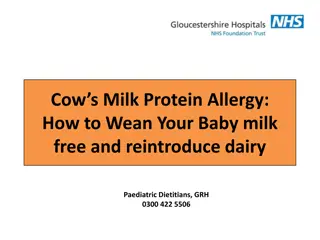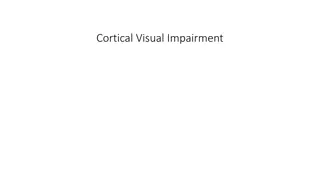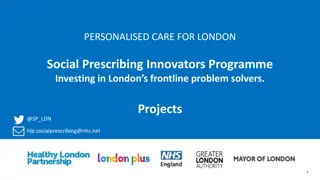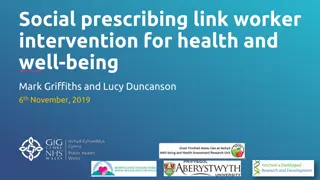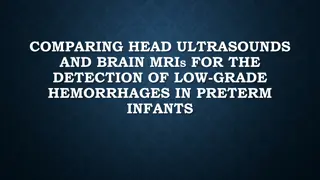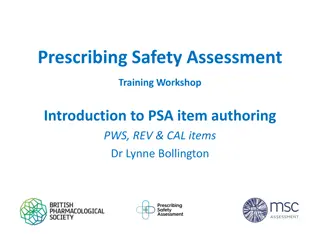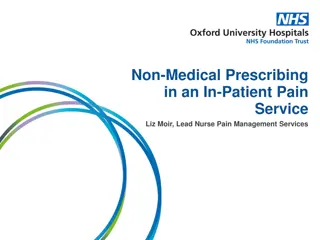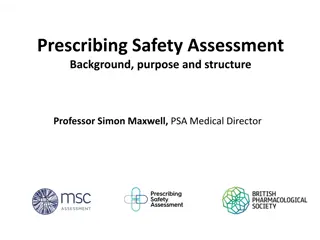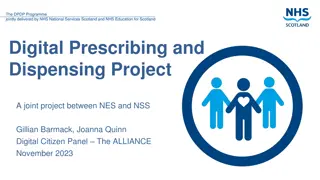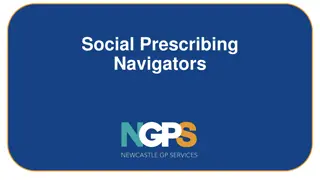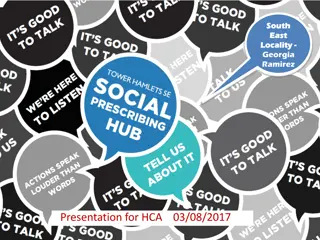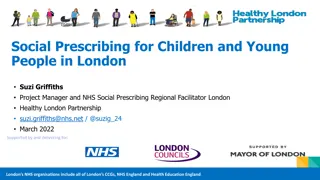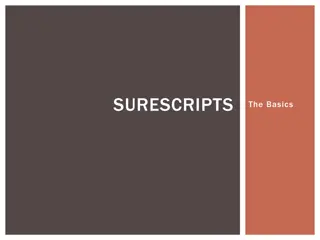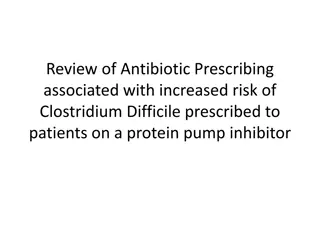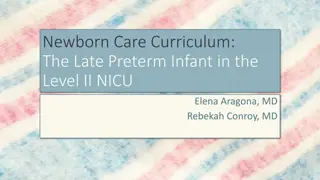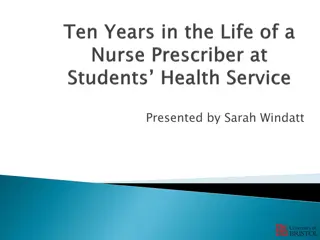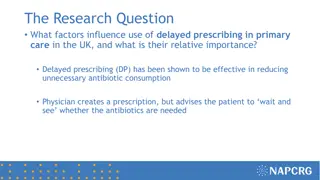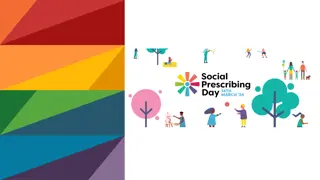Spectacle Prescribing Guidelines for Infants and Children
This paper explores guidelines for prescribing spectacles to infants and children, focusing on considerations such as refractive errors, normal visual development, and the impact of spectacles on visual function and emmetropisation. It discusses refractive errors and astigmatism prevalence from birth to six years, highlighting factors like anisometropia in young children. The refractive errors in 3 to 6-year-olds and the shift towards emmetropia are also touched upon.
Download Presentation

Please find below an Image/Link to download the presentation.
The content on the website is provided AS IS for your information and personal use only. It may not be sold, licensed, or shared on other websites without obtaining consent from the author. Download presentation by click this link. If you encounter any issues during the download, it is possible that the publisher has removed the file from their server.
E N D
Presentation Transcript
Paediatric Prescribing and Referrals E and N Herts NHS Trust Ophthalmology Dept.
To prescribe or not to prescribe? Guidelines for spectacle prescribing in infants and children Susan Leat (2011) This paper discusses considerations for spectacle prescribing in infants and children, with reference to current literature. The focus is on children who do not have other disorders, e.g.: strabismus, significant heterophoria or convergence excess. However amblyogenic factors are discussed. These guidelines are just an aid, the clinician must make decisions when examining a child.
Infants and children from birth to six years Consider the following: Is the refractive error within the normal range for the child s age? Will this refractive error emmetropise? Will this level of refractive error disrupt normal visual development? Will prescribing spectacles improve visual function? Will prescribing spectacles interfere with emmetropisation?
Refractive error from birth to 3 years The range of refractive error is wider at birth and in the first year of life than in later childhood. Most infants are hypermetropic. Average cycloplegic refractive error is +2.00D with a standard deviation of approx. 2.00D A few infants are myopic at birth. Most infants will emmetropise.
Refractive error from birth to 3 years There is also a higher prevalence of astigmatism at birth. 69% of newborns have astigmatism of 1.00D or more. All types of astigmatism decrease, infants lose approx two-thirds of their astigmatism between 9 and 21 months.
Refractive error from birth to 3 years Anisometropia is more common in children than adults. Approximately 7-11% of 1-4 year olds have anisometropia of 1.00D or more, compared to 0- 5% of school children. These are not the same children. Some children gain anisometropia, while others lose it. Higher levels (3.00D or more) are more likely to remain.
Refractive error in 3 to 6 year olds There is less change during this period of life. Gwiazda and colleagues showed a slow movement towards emmetropia. At age 6 the mean refractive error is 0.70 to 1.00D. There is less change in astigmatism, although Gwiazda showed some decrease until approx 4-5 years.
Will this childs refractive error emmetropise? The majority of children will emmetropise, but not all. There is some evidence that children with very high refractive errors are less likely to emmetropise. There is an association between lack of emmetropisation and strabismus. The main tool to predict emmetropisation is to monitor the refraction.
Will this childs refractive error emmetropise? Those that emmetropise lose approx half of their spherical equivalent refractive error in the first year, and approx one-third between 9 and 21 months. Two-thirds of the astigmatism is lost between 9 and 21 months. Anisometropia can be transient, but if it is 3.00D at one year of age there is a high risk of it remaining. (Monitor, consider VAs). Children with low vision are less likely to fully emmetropise.
Will this level of refractive error disrupt normal visual development? Uncorrected high refractive error during the first few years of life is a risk factor for amblyopia. Aurell and Norrsell found that infants with more than +4.00D were more likely to develop esotropia. Poorer VA, accommodation and stereopsis have been associated with high hypermetropia.
Will this level of refractive error disrupt normal visual development? In 3-4 year olds, 1.50D of astigmatism is associated with poorer recognition acuity. Anisometropia after age 3 is more likely to cause amblyopia than before that age.
Will prescribing spectacles improve visual function? Amblyopia due to high hypermetropia responds to treatment with refractive correction.
Will prescribing spectacles interfere with emmetropisation? Experimental animal studies show that refractive correction influences the development of refractive error. Ingram and colleagues found the compliant spectacle wearers emmetropised less than the non-compliant spectacle wearers or controls. We cannot assume that prescribing spectacles does not influence refractive development.
Children in the school years Emmetropisation is essentially complete by six years. The refraction of children with moderate hypermetropia still shows a drift towards emmetropia up to 9 or 10 years, then myopia commences. Under correction of myopia may lead to further progression. +1.50D of hypermetropia should be considered for correction, even if asymptomatic.
Management Factors that indicate the need for spectacle prescribing: Reduced uncorrected vision Reduced corrected visual acuity Reduced stereopsis Reduced accommodation Signs and symptoms such as poor co- ordination, asthenopia, headaches
Management Monitor the refractive error in infants and toddlers before prescribing. Unchanging or increasing refractions are associated with amblyopia. We could prescribe to bring the uncorrected portion just within the normal range, leaving a large stimulus for emmetropisation. (These children may be at more risk of developing esotropia).
Management Another option, prescribe to leave the uncorrected portion equal to the average for the age. This gives the child an average stimulus for emmetropisation. This may not be the optimal stimulus for emmetropisation considering their higher than normal level of hypermetropia. The approach suggested here is to leave the uncorrected portion just above the mean for the age.
Management In the pre-school years the general rule is to under correct the refractive error while emmetropisation is active. Unless other factors outweigh the need to leave a stimulus for emmetropisation, i.e.: amblyopia, strabismus. In anisometropia full refractive correction alone often results in improvements in VA.
Management In infancy most myopia can be monitored. From age 1 they are likely to benefit from a reduced myopic correction, to maintain some stimulus for emmetropisation. When prescribing for school children, the full non-cycloplegic subjective refraction can be considered.
Mayer and colleagues (Clinical, cross sectional, predominantly white population) Age (Months) Mean SE (D) Lower 95% range (D) Upper 95% range (D) 1 2.2 -1.1 5.5 6 1.8 -0.8 4.4 9 1.3 -1.0 3.6 12 1.6 0.00 3.2 24 1.2 -0.6 3.1 36 1.0 -0.6 2.6 48 1.1 -0.6 2.9
Hypermetropia When to consider prescribing What to prescribe Comments, rationale and references Outside the 95% range of refraction Leave the uncorrected hypermetropia above the mean for age See previous table 3 to 6 months if outside 95% range Partial Rx if VA poorer than 6/100 and astigmatism >3.25D at age 1 year Partial prescription (1.00D less sphere, half cyl) Atkinson s protocol >2.50D at age 4 years Undercorrect by 1.00D to 1.50D (as child does not need full hypermetropic correction) Based on studies of visual function and functional vision >1.25D in the school years A full correction may be given as emmetropisation has ended Studies show that +1.00D to +2.00D may impact visual function
Astigmatism When to consider prescribing What to prescribe Comments, rationale and references >2.50D at age 15 months Undercorrect cyl by 1.00D or give 50% 15 months is the most critical period for development of meridional amblyopia >1.75D at age 2 years Partial cyl up to 3 to 4 years, then give full cyl Based on findings of better VA in children whose astig was corrected at this age >1.25D at age 4 years Give full cylinder Functional benefits Correct oblique astig >0.75D from 1 year Author s clinical instinct: uncorrect by one-third to age 2, then give the full Oblique astigmatism is a risk factor for amblyopia >0.50D at school age Give full cylinder Congdon and colleagues found correction at this level improved VA
Myopia When to consider prescribing What to prescribe Comments, rationale and references >-5.00D, during first year Reduce by 2D for emmetropisation MPED study less than 1% of children between 6 and 72 months had -4.00D >-2.00D from one year old or walking Reduce by 0.50D or 1.00D until school age (emmetropisation) Clinical opinion varies widely 4 years to early school years <-1.00D or lower if it improves VA, can give full Congdon and colleagues found that correcting <1.00D improved VA School age children Prescribe full correction ?consider myopia control
Aphakia or pseudophakia When to consider prescribing What to prescribe Comments, rationale, and references In first few months Overcorrect by 2.00D to 3.00D as child s world is near, reducing to a single vision intermediate add of 1.00 to 1.50D by 1 year. Contact lenses are often the correction of choice. IOLs may be implanted at surgery. 2 to 3 years onwards Distance correction with bifocals. They will require bifocals/PALs for life.
Anisometropia When to consider prescribing What to prescribe Comments, rationale and references Anisometropia with amblyopia Correct the full anisometropia and astig but correct the hypermetropia or myopia according to age. >2.75D at 1 year old Prescribe full anisometropia as above if amblyopia is present. Anisometropia of 3.00D or greater is less likely to be transient. >0.75 but <3.00D after 1 year of age Monitor for 4-6 months, if persists prescribe as above. Based on reports of transient anisometropia. >0.75D of spherical hypermetropic anisometropia, >1.75D of spherical myopic anisometropia or >1.25D of cylindrical aniso after age 3.5 years Prescribe as above. If amblyopia is absent, monitor first. These levels of anisometropia have been found to be amblyogenic at this age.
Referrals Peer discussion
Px: PB Px: AM Age 3 years old Female. RFV: Parents have noticed left eye turning in. GH: good, no medication, normal birth FH: mother had a turn which resolved as she grew up Age: 5 years old Female Px attended for first eye exam. Hypermetropia and reduced vision was found. Spectacles have not been issued. Please refer to an HES clinic. Unaided visions: R 6/9 L 6/9 (measured with Kay s pics.) Unaided visions: R 6/24 Cover test: Distance and near: L esotropia L 6/24 Cover test: Distance and near: orthophoria Stereopsis: No answers given (?px shy) Refraction: R+2.00DS 6/9 L +4.50DS 6/9 Cycloplegic refraction: R +10.50/-2.00 x 150 L +11.00/-2.00 x 40 External eye and fundi: Appears healthy, but poor view due to co-operation. External eye and fundi: Appears healthy To discuss: Would you do any other tests? Would you prescribe spectacles? What would you prescribe? Would you refer this child? If so, how urgently? If the child didn t have an esotropia what would you do differently (if anything)? To discuss: Would you do any other tests? Would you prescribe spectacles? What would you prescribe? Would you refer this child? If so, how urgently? If the child had an esotropia what would you do differently (if anything)?
Would you do any other tests? Would you prescribe spectacles? What would you prescribe? Would you refer this child? If so, how urgently? If the child didn t have an esotropia what would you do differently (if anything)?
PB Cycloplegic refraction Check ocular motility to rule out 6th nerve palsy Cover test with refraction GIVE SPECS! Full hypermetropic Rx, for full time wear Routine referral (if accommodative) Urgent referral if nerve palsy If no esotropia, still give Rx (full time) to avoid amblyopia
Would you do any other tests? Would you prescribe spectacles? What would you prescribe? Would you refer this child? If so, how urgently? If the child hadanesotropia what would you do differently (if anything)?
AM Ocular motility and steropsis. Vision is reduced and cycloplegic refraction has been done, so give spectacles. No strabismus, so can issue a reduced prescription. If VA remains reduced at next visit, increase prescription/routine referral to HES. If esotropia, give full hypermetropic correction
Quiz time! You see a child with reduced vision and refractive error, would you prescribe spectacles? You see a 7 year old with intermittent, horizontal diplopia. Cover test reveals near exotropia. Where would you refer this px? Eye casualty? Routine orthoptist? You see a baby with a constant exotropia. Where would you refer this px? Eye casualty? Routine orthoptist?
You see a child with an esotropia and high hypermetropia. Do you give the full plus? Or reduce the plus?
Unaided R 6/6 L 6/12 Cycloplegic refraction: R +1.00DS L +4.00DS You prescribe R plano L +3.00DS How often would you advise the px wears their specs? Full time? Or for concentrated visual tasks? Or just for reading? 3 months later the vision is still 6/12 on the left eye. What next?






